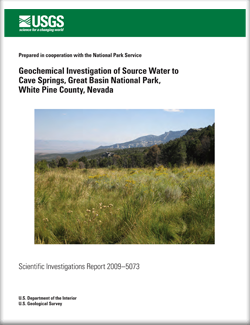 Abstract Abstract
Cave Springs supply the water for the Lehman Caves Visitor Center at Great Basin National Park, which is about 60 miles east of Ely, Nevada, in White Pine County. The source of water to the springs was investigated to evaluate the potential depletion caused by ground-water pumping in areas east of the park and to consider means to protect the supply from contamination. Cave Springs are a collection of several small springs that discharge from alluvial and glacial deposits near the contact between quartzite and granite. Four of the largest springs are diverted into a water-collection system for the park. Water from Cave Springs had more dissolved strontium, calcium, and bicarbonate, and a heavier value of carbon‑13 than water from Marmot Spring at the contact between quartzite and granite near Baker Creek campground indicating that limestone had dissolved into water at Cave Springs prior to discharging. The source of the limestone at Cave Springs was determined to be rounded gravels from a pit near Baker, Nevada, which was placed around the springs during the reconstruction of the water-collection system in 1996.
Isotopic compositions of water at Cave Springs and Marmot Spring indicate that the source of water to these springs primarily is from winter precipitation. Mixing of water at Cave Springs between alluvial and glacial deposits along Lehman Creek and water from quartzite is unlikely because deuterium and oxygen‑18 values from a spring discharging from the alluvial and glacial deposits near upper Lehman Creek campground were heavier than the deuterium and oxygen-18 values from Cave Springs. Additionally, the estimated mean age of water determined from chlorofluorocarbon concentrations indicates water discharging from the spring near upper Lehman Creek campground is younger than that discharging from either Cave Springs or Marmot Spring. The source of water at Cave Springs is from quartzite and water discharges from the springs on the upstream side of the contact between quartzite and granite where the alluvial and glacial deposits are thin. Consequently, the potential for depletion of discharge at Cave Springs from ground-water pumping in Snake Valley east of the park is less than if the source of water was from alluvial and glacial deposits or carbonate rocks, which would be more directly connected to downstream pumping sites in Snake Valley.
|
Part or all of this report is presented in Portable Document Format (PDF); the latest version of Adobe Reader or similar software is required to view it. Download the latest version of Adobe Reader, free of charge. |